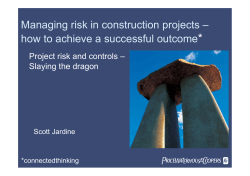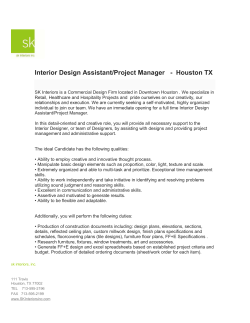
Website launches scaled down or cancelled. Corporate communication
How to Contract Creative Services to Meet Leaner Budgets Website launches scaled down or cancelled. Corporate communication programs eliminated. Awareness campaigns put on hold. Invoices scrutinized. The last several years have forced us all to adapt to a climate of lean marketing budgets and scarce dollars for new initiatives. But work must go on. The last thing an organization can afford to do is become invisible. If you’re responsible for contracting creative services for your organization, here are some tips that will help you and your design team work together to continue moving forward and keep costs down. • Set clear goals. Take the time to write out a creative brief, a statement of the work to be accomplished. It will force you to anticipate and answer the questions a creative services firm will ask, and it will give you something that key players in your organization can read and buy into before any design charges are incurred. A clear statement of work will ensure that everyone stays focused on original goals as the strategy develops. What should you include in the brief? Begin with a short description of what you do as an organization. State your objectives for this work—who your target audience is, the response you want from them, the schedule, budget (even a ball park) and specific limitations that would impact the design solution such as corporate identity requirements, the relationship of this project to existing materials, and plans for distribution. A written statement is especially useful if you’re requesting estimates from more than one firm. Comparing proposals can be time-consuming and inaccurate if your bidders are responding to incomplete or inconsistent information. • Identify the decision makers. The quickest way to send costs into the out-of-control category is to include everyone in the decision-making process. Design by committee is expensive and frequently results in a product that satisfies no one and fails to engage your target audience. Limit the number of people on your staff who will be part of the approval process, and designate one person to serve as the point of contact with your design team. Have designers present concepts directly to the person or persons who have authority to approve them. That even includes your busy CEO or department head, if he or she has the final say. • Examine the contract. Ask questions before you sign any creative services contract. Ownership of final art, reuse of photography and illustration and other clauses can greatly affect the bottom line. Here’s just one example: design revisions. Some creative services firms will make design changes until the cows come home for one set price. Most won’t. Is the cost for revisions included in the base fee, or will you see an additional line item on your invoice? Resource Paper page 2 AIGA, the design community’s professional association, has set industry standards to deal with issues that have a big impact on your costs. You can review AIGA’s Standard Form of Agreement for Design Services online at www.aiga.org/archivedmedia/design-business-andethics/aiga_9standard_agreement_09.pdf. Many design firms follow these guidelines for contracts, but not all. By reading the statement you’ll understand what to look for in the contract with your creative firm. • Organize, organize, organize. Whenever you deliver content to your creative team, make it complete, clear and error-free. Text files should be as close to final as possible and have the necessary legal or other internal approvals in place. Providing content in bits and chunks may feel like progress because work is moving off your desk. This is a special problem in web site development. But when your designers are dealing with pieces instead of a whole, project management costs increase and so does the chance for error. Have a detail-oriented person on your staff comb through content for errors or style inconsistencies, especially on long files. Even with search-andreplace or spell check tools, it takes careful proofing and a questioning eye to make sure copy is ready to go. • Review each stage carefully. Make sure you aren’t overlooking potential problems in your eagerness to finish the job. Ask lots of questions. Digital proofs for printed pieces may look great on screen, but remember they are just proofs and a far cry from paper and ink. Look at test versions of web pages with the same critical eye, too. Voice every question or concern you have about color, text presentation and photo quality. If you and your design team don’t have the same expectations for the final product, you could face a costly reprint or redevelopment that will blow your schedule and your budget. • Take a little risk. Set clear budgets with your marketing firm and agree upon limits, then turn them loose to do what they do best—come up with creative, memorable, effective solutions. The purpose in contracting for design services is to set your organization apart from the competition or call people to action. Nothing is achieved by blending in with the crowd. Designs may need to push your comfort level in order to draw a response that will really meet the goals you’ve set. • Build on the outcome. Probably the most productive meeting in the life of a job occurs after it’s done. When the web site has been launched, the brochure has been distributed, or the book has been published, a recap meeting with your design team is invaluable. Evaluate the process together—what worked and where improvements can be made. Building a relationship for the future means you have a team on-call that knows your organization and can step in quickly with appropriate strategies, smart solutions and budgets that work. Resource Paper page 3 Costs will creep up—or leap up—if you skimp on these important steps. Use them, and you’ll be rewarded with great communication and marketing tools— and no-shock invoices at the end. Cynthia Fowler is a writer for Graves Fowler Creative (www.gravesfowler.com), a digital design agency that serves cause-related, government and corporate clients. The company was founded in 1984 and has offices near Washington, DC.
© Copyright 2025





















